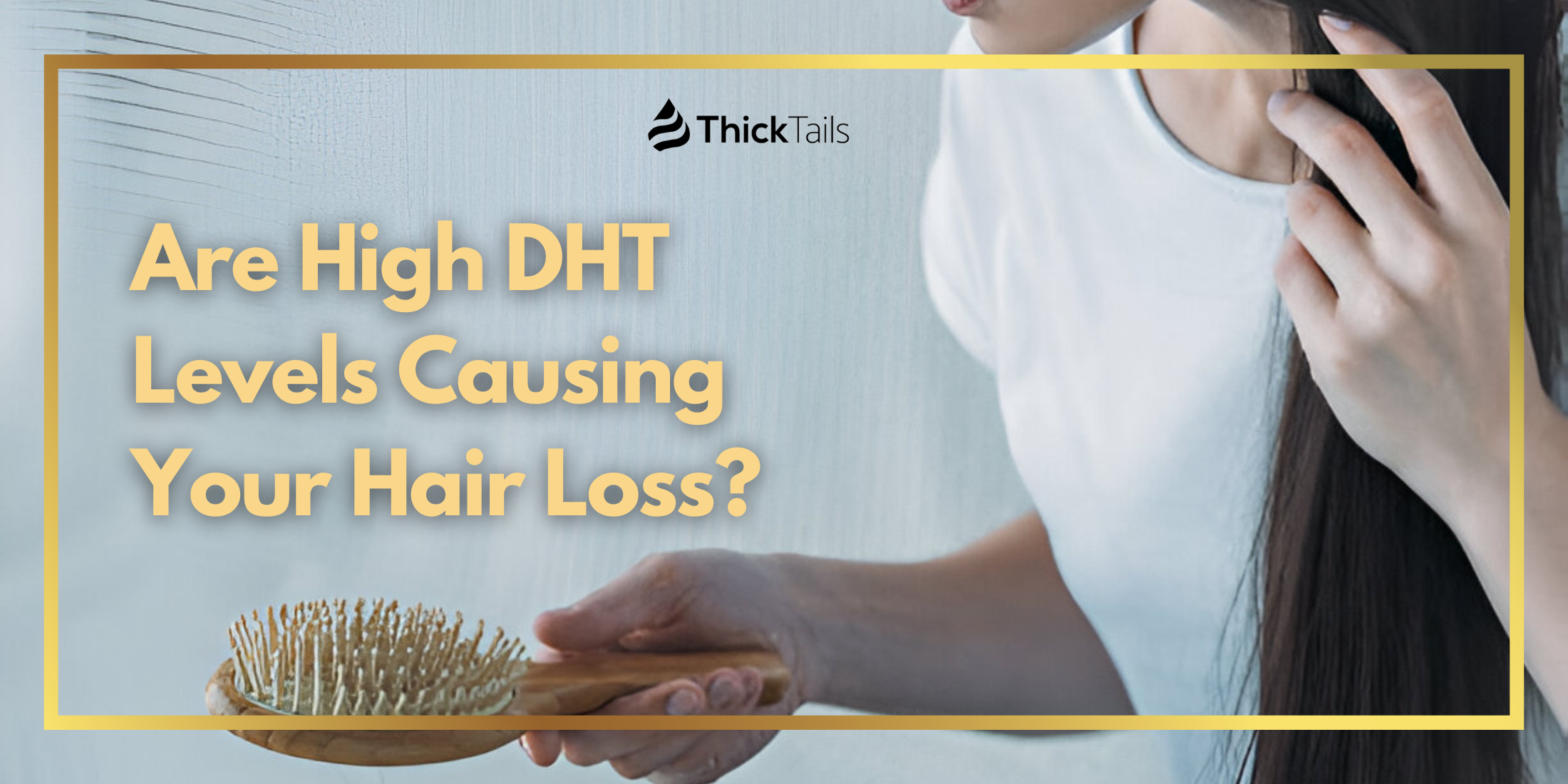If you've been noticing more hair in the shower drain or less volume in your ponytail, you're not alone. Hair loss in women is more common than many realize, and oftentimes, it can be linked to something unexpected—high DHT levels. But what exactly is DHT, and how does it impact your hair health?
This blog dives into the science behind DHT, explores how it can lead to hair thinning in women, and importantly, offers actionable tips to manage DHT levels and protect your locks. Whether you're experiencing postpartum hair loss, general thinning, or are simply curious about hair health, this guide has you covered.
Understanding the Role of DHT in Female Hair Thinning

DHT, or dihydrotestosterone, is a hormone derived from testosterone that plays a significant role in hair loss, particularly thinning hair in women. When DHT binds to hair follicles, it can cause them to shrink over time, leading to weaker strands and eventually hair loss. Understanding this process is crucial for addressing the root causes of female hair thinning effectively.
What Is DHT and Why Women Produce It Too
Dihydrotestosterone (DHT) is a hormone derived from testosterone, which both men and women naturally produce. While most associate DHT with male pattern baldness, women can also experience hair loss due to this hormone. DHT plays a role in various bodily functions, but when levels are too high or when hair follicles are especially sensitive, trouble begins.
Hair follicles have receptors for DHT, and when this hormone binds to them, it can negatively affect how the follicles function.
How DHT Shrinks Hair Follicles and Slows Growth
Here’s where science meets your hairline. DHT attaches itself to hair follicles, shrinking and weakening them over time in a process called "miniaturization." This causes the hair strands to thin and grow weaker with each cycle of growth, eventually leading to dormant follicles that no longer produce hair.
For women, this often occurs across the crown or thinning near the part line. Though full baldness is rare, the progressive thinning can be frustrating and upsetting.
Signs That Point to DHT-Driven Hair Loss in Women
How do you know if high DHT may be the culprit? Here are a few common signs:
- Widening part line: If you notice a significant change in the density of your hair along your part, this could point to androgen activity.
- Thinning at the crown or temples: DHT-driven hair loss tends to follow distinctive patterns.
- Increase in shedding: If large amounts of hair fall out during brushing or washing, it may be time to investigate hormonal factors.
- Slow regrowth: Strands that grow back thinner or take far too long to reach length could be a DHT-related issue.
If these symptoms are sounding familiar, it’s time to take a closer look.
How to Identify and Confirm DHT-Related Hair Loss
Identifying and confirming DHT-related hair loss requires careful observation and consultation. Start by examining the pattern and progression of hair thinning, particularly at the crown or temples, as these are common areas affected by DHT. Additionally, consider tracking the frequency of hair shedding and the quality of regrowth over time. If the signs point towards hormonal factors, seeking advice from a medical professional or dermatologist can help confirm the diagnosis and provide tailored solutions.
Hormone Testing and Scalp Pattern Indicators
A medical professional can confirm whether your hair loss may be linked to high DHT through hormone testing. Blood tests that measure androgen (including testosterone and DHT) levels can provide concrete answers. Additionally, dermatologists can examine your scalp for patterns that align with DHT-related thinning.
The Difference Between DHT Hair Loss and Other Causes
Not all hair loss is caused by DHT. For example, stress (also known as telogen effluvium), nutritional deficiencies, and medical conditions like hypothyroidism or anemia can lead to temporary or permanent thinning.
What sets DHT-related hair loss apart is the gradual miniaturization of hair follicles, leading to progressive thinning that doesn’t grow back without intervention.
When to Suspect Androgen Sensitivity in Hair Follicles
If your hormone levels are within normal range yet you’re still experiencing thinning, it could be due to androgen sensitivity. Some women are naturally more prone to hair follicle reactions to otherwise low-to-normal DHT levels. A family history of female-pattern hair loss increases the chances, too.
Managing DHT to Support Healthy Hair Growth

Once you've diagnosed the issue, it’s time to take action. Here’s how to manage DHT and nurture healthier, thicker hair over the long term.
Natural DHT Blockers in Supplements and Diet
Some foods and supplements contain compounds that naturally counter the effects of DHT:
- Saw Palmetto: Often found in hair growth supplements, saw palmetto has been shown to block DHT activity by inhibiting the enzyme that converts testosterone into DHT.
- Pumpkin Seed Oil: Rich in zinc and phytosterols, pumpkin seed oil supports scalp health while reducing DHT's effects.
- Green Tea: EGCG, a compound present in green tea, may help prevent hair loss by reducing DHT activity.
- Omega-3 Fatty Acids: Found in foods like fish or flaxseeds, omega-3s combat inflammation that can exacerbate DHT-driven follicle damage.
Adding these ingredients to your diet or as part of a targeted supplement can aid in managing DHT levels.
Choosing Shampoos, Conditioners, and Serums That Support Hormonal Balance
When selecting shampoos, conditioners, and serums to support hormonal balance, it’s essential to choose products formulated to combat hair loss caused by DHT. Look for ingredients such as caffeine, biotin, and saw palmetto, which are known to block DHT's impact on hair follicles and promote healthy hair growth. Opting for sulfate-free and paraben-free products can also help maintain scalp health and reduce irritation, further supporting hair retention.
Not all hair products are created equal. When dealing with DHT-related hair loss, it’s essential to choose targeted formulations designed to block DHT or minimize scalp build-up. Look for:
- Shampoos: Opt for DHT-blocking shampoos containing ingredients like ketoconazole, biotin, and caffeine to cleanse and strengthen the scalp.
- Conditioners: A good conditioner should focus on hydration and fortification without weighing the hair down. Formulas with argan oil or collagen are excellent choices.
- Serums: Lightweight and designed for direct scalp application, serums with active ingredients like niacinamide or zinc can help combat DHT and improve circulation.
Long-Term Scalp Care Strategies for DHT Regulation
Caring for your scalp over the long term is crucial to minimizing DHT's effects. Here are some must-try strategies:
- Regular Scalp Massages: Massaging promotes blood circulation and encourages healthier hair follicles.
- Microneedling: This emerging treatment creates tiny punctures in the scalp, which boosts collagen production and improves the absorption of DHT-blocking serums.
- Stay Consistent with Products: It can take weeks or even months for your shampoos, conditioners, or hair serum to show results, so patience and commitment are essential.
- De-stress: Elevated stress can exacerbate hair loss by triggering more DHT production, so prioritize relaxation techniques like yoga or meditation.
Taking Back Control of Your Hair Health
Regardless of the cause, hair loss can feel overwhelming. But with the right approach and tools, it’s absolutely manageable. Addressing DHT levels through proper testing, products, supplements, and scalp care can make a dramatic difference in your hair health over time.
If you suspect your thinning hair is linked to DHT, take action today by incorporating DHT blockers into your routine, investing in targeted shampoos and serums, and opting for a hair-healthy diet. Small, consistent changes will gradually improve the health and resilience of your hair.
Remember, your hair is as unique as you are. What works for one person may not work for another, so don’t be discouraged. A professional evaluation or consultation can also provide tailored advice if you’re unsure where to start.










